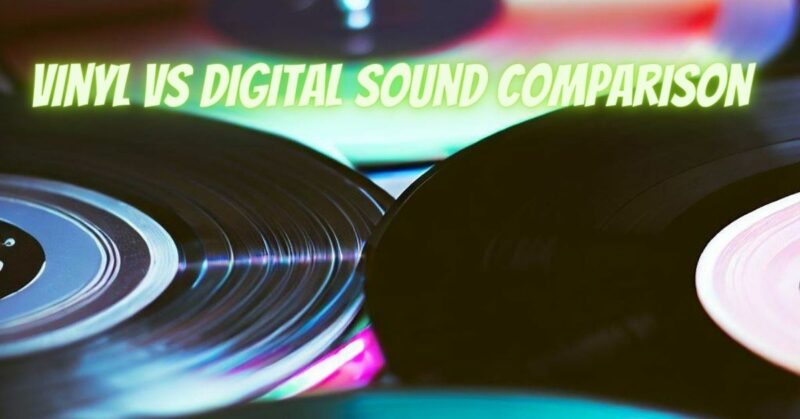The debate between vinyl and digital audio has been ongoing for decades, with passionate advocates on both sides. Vinyl records, with their analog warmth and tactile experience, hold a special place in the hearts of audiophiles. Digital formats, on the other hand, offer convenience and precision. In this article, we will explore the differences between vinyl and digital sound, examining the characteristics, advantages, and limitations of each format to help you decide which might be the better choice for your music listening preferences.
Vinyl Sound Characteristics:
Vinyl records are celebrated for their unique sound characteristics:
- Analog Warmth: Vinyl records are revered for their analog warmth, which imparts a rich, organic quality to the sound. The analog format allows for a continuous, smooth representation of audio, resulting in a unique and pleasing tonal quality.
- Natural Distortion: Vinyl records tend to introduce natural, pleasing harmonic distortion, especially when the stylus encounters loud passages. This distortion is often perceived as a desirable “warmth” by audiophiles.
- Tactile Experience: Playing vinyl records is a tactile experience. Handling the physical medium, carefully placing the stylus, and observing the spinning platter are integral to the vinyl listening experience.
- Artwork and Collectibility: Vinyl records offer large, tangible album artwork and packaging, making them highly collectible and appealing to those who appreciate the visual artistry of album covers.
Digital Sound Characteristics:
Digital audio, in the form of CDs and streaming, offers a distinct set of characteristics:
- Clarity and Precision: Digital audio is known for its clarity and precision. It faithfully reproduces the recorded sound without introducing harmonic distortion or surface noise.
- Convenience and Portability: Digital formats provide convenience and portability, allowing for easy storage and playback on various devices, from smartphones to high-end audio players.
- Vast Catalog: Digital formats offer access to an extensive catalog of music, including both new releases and back-catalog titles, providing a wide range of choices for listeners.
- Consistency: Digital audio is consistent across plays, making it immune to wear and tear. Listeners can expect the same sound quality every time.
Advantages and Limitations:
Advantages of Vinyl:
- Analog Warmth: The analog warmth and harmonic distortion of vinyl can be emotionally engaging, especially for those who appreciate a vintage and organic sound.
- Tactile Experience: The hands-on experience of vinyl playback, from handling the record to cueing the stylus, adds a sense of ritual and connection to the music.
- Collectibility: Vinyl records hold intrinsic and aesthetic value for collectors, with limited editions and rare releases being highly sought after.
Limitations of Vinyl:
- Fragility: Vinyl records are susceptible to damage, warping, and scratching, which can affect their sound quality and longevity.
- Limited Dynamic Range: Vinyl records have limitations in terms of dynamic range, which may not fully capture the nuances of modern, highly compressed recordings.
Advantages of Digital:
- Clarity and Precision: Digital audio provides high-fidelity sound with exceptional clarity and precision.
- Convenience: Digital formats offer convenience, portability, and the ability to carry your entire music library in your pocket.
- Vast Catalog: The extensive catalog available through digital streaming services ensures a vast selection of music.
Limitations of Digital:
- Lack of Analog Warmth: Some listeners miss the analog warmth and character offered by vinyl records when listening to digital audio.
- Lossy Compression: Compressed digital audio formats like MP3 can result in some loss of audio quality, particularly at lower bit rates.
The choice between vinyl and digital audio ultimately depends on your personal preferences and priorities as a music listener. Vinyl records offer a unique, analog warmth and a tactile experience, while digital formats provide unparalleled convenience, clarity, and portability.
The ongoing vinyl vs. digital debate highlights the diverse listening preferences and priorities of music enthusiasts. Some listeners cherish the tangible and vintage qualities of vinyl, while others prefer the accuracy and convenience of digital audio. Ultimately, both formats have their distinct charms and can coexist harmoniously in the diverse world of music consumption. The choice is yours to make, guided by what matters most in your own musical journey.

